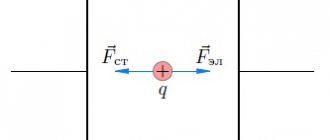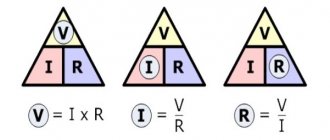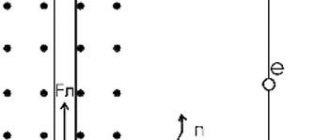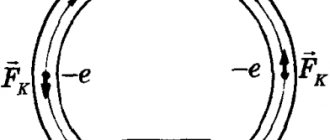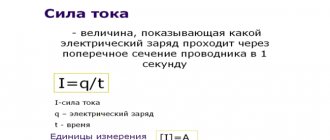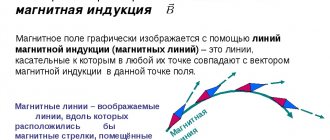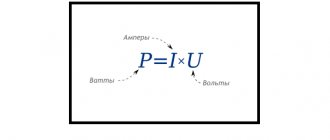Operating principle
To understand how electromagnets work, we need to look at their design. A simple device explains the principle of operation of an electromagnet. When an electric charge flows through the body of the winding, magnetic field radiation occurs, penetrating the magnetic circuit.
Magnetic flux formula
Inside a metal or ferromagnet, in accordance with the laws of physics, microscopic magnetic fields called domains are formed. Their fields, under the external influence of the winding, are arranged in a certain order. As a result, the magnetic forces of the domains are summed up, forming a strong magnetic field, giving the magnetic circuit the ability to attract massive metal objects.
Important! To stop electromagnetic induction, it is enough to disconnect the EM from the current source. In this case, a particle of the magnetic field will remain. This effect is called hysteresis.
Industry
Probably everyone has seen at least once a variety of such a device as a lifting electromagnet. This is a thick “pancake” of various diameters, which has a huge attractive force and is used to carry cargo, scrap metal and any other metal in general. Its convenience lies in the fact that it is enough to turn off the power and the entire load is immediately unhooked, and vice versa. This greatly simplifies the loading and unloading process.
The strength of the electromagnet, by the way, is calculated using the following formula: F=40550∙B^2∙S. Let's look at it in more detail. In this case, F is the force in kilograms (can also be measured in newtons), B is the induction value, and S is the working surface area of the device.
Classification
Magnetic field energy density
EMs are distinguished by the methods of creating magnetic fields. There are three types of electromagnets:
- AC electromagnet;
- neutral DC device;
- polarized DC EM.
Magnets operating on alternating current change the direction of the magnetic flux along with twice the frequency of the electric current.
Neutral EMs connected to a direct current source create magnetic fluxes that do not depend on the direction of the electric current.
In polarized devices, the orientation of the magnetic flux is tied to the direction of the electric current. Polarized EMs consist of two magnets. One of them directs a polarizing magnetic field flux to the second electromagnet to turn it off.
Kinds
Electromagnets are of the following types:
- Neutral DC. In such a device, magnetic flux is created by means of a direct electric current passed through a winding. This means that the force of attraction of such an electromagnet varies depending only on the magnitude of the current, and not on its direction in the winding.
- Polarized DC. The action of an electromagnet of this kind is based on the presence of two independent magnetic fluxes. If we talk about polarizing, then its presence is usually created by permanent magnets (in rare cases - by additional electromagnets), and it is needed to create an attractive force when the winding is turned off. And the action of such an electromagnet depends on the magnitude and direction of the electric current that moves in the winding.
- Alternating current. In such devices, the electromagnet coil is powered by alternating current electricity. Accordingly, with a certain periodicity the magnetic flux changes its direction and magnitude. And the force of attraction varies only in magnitude, which is why it “pulsates” from a minimum to a maximum value with a frequency that is twice the frequency of the electric current feeding it.
We have already become familiar with what types there are. Now let's look at examples of using electromagnets.
Advantages of using electromagnets
The main advantage of an electric magnet over a constant source of magnetic field is that it is brought into working condition under the influence of electric current. That is, when it is necessary to exert a magnetic influence on a certain part of space, the current is turned on. This allows for rhythmic operation of the EM, which is successfully used in various types of electrical equipment, instruments and devices.
An electromagnet can be found in electric meters, separator units, transformers, television and audio equipment and other devices.
Powerful magnets are installed on overhead cranes in the workshops of metallurgical plants and winches of scrap metal collection enterprises.
Lifting electromagnets
One of the first applications of EMs is as speakers. The sound device is based on an electromagnet, which causes the membrane to vibrate in the audio range.
EMs are used in metal detectors to detect metal-containing objects underground, in water and in various areas.
Historical data
The first to create an electromagnet was W. Sturgeon. His device was a curved rod made of soft iron, around which thick copper wire was wound. To isolate the rod from the winding, it was coated with varnish. Due to the supply of current, the rod was endowed with properties characteristic of strong magnets; interruption of recharge led to the loss of all properties. It is this characteristic that has led to their widespread use in technology. On the pages of the “Encyclopedic Dictionary of Brockhaus and Efron” there is a mention that electromagnets were used back in the 19th-20th centuries; M.E. Mendelssohn noted that electromagnets are a good means of removing foreign objects from the eye cavity.
Superconducting electromagnet
Superconductivity is considered the property of materials with resistance close to zero. Electromagnets with practically zero resistance have a super-powerful magnetic field. The force of magnetic influence can cause diamagnetic materials such as pieces of lead and organic objects to float in space.
As physicists have noticed, metals acquire the property of superconductivity at ultra-low temperatures. To obtain the superconductivity effect, the EM windings are placed in a Dewar flask with liquid helium, which is equipped with a valve to release the vapor of the substance. Superconducting magnets are used in medical equipment - MRI (magnetic resonance tomography) machines. Experimental hovercraft trains use superconducting magnets.
Superconducting magnet
Magnetism and electricity
The dictionary definitions of electricity and magnetism are different, although they are manifestations of the same force. When electric charges move, they create a magnetic field. Its change, in turn, leads to the generation of electric current.
Inventors use electromagnetic forces to create electric motors, generators, MRI machines, levitating toys, consumer electronics and many other invaluable devices without which it is impossible to imagine the daily life of a modern person. Electromagnets are inextricably linked with electricity; they simply cannot work without an external power source.
How to make a 12v electromagnet
The easiest way to make an electromagnet is to take a regular nail, wire and battery. An insulated wire is wound along the entire length of the rod. The ends of the conductor are pressed against the poles of the battery. To ensure that the charge is not wasted, one end of the wire is soldered to the positive contact. The other ending should be made in the form of a spring-loaded arc, which is pressed against the battery terminal with a minus sign. The bottom photo shows how you can make an electromagnet at home.
DIY electromagnet
Note! When making an electromagnet with a battery, you can use a contact block from an old device. To turn off the magnet, it will be enough to remove the battery from the contact box.
Story
William Sturgeon is considered the creator of the electromagnet. It was he who made the first such magnet in 1825. Structurally, the device was a cylindrical piece of iron, around which a thick insulated copper wire was wound. At the moment when an electric current was passed through it, the metal rod acquired the properties of a magnet. And when the flow of current was interrupted, the device immediately lost all magnetism. It is precisely this quality - turning on and off when necessary - that allows the use of electromagnets in a number of technological and industrial fields.
We looked at the question of what an electromagnet is. Now let's look at its main types. They are divided depending on the method of creating the magnetic field. But their function remains the same.
Calculations
Before you start assembling an electromagnet with your own hands, make a preliminary calculation of its parameters. Structural elements are calculated separately for DC and AC EVs.
For DC
Before making calculations, the required value of the magnetomotive force (MF) of the coil is determined. The winding parameters must provide the required MMF, at the same time the coil must not overheat, otherwise the insulating layer of the winding wire will be lost. The initial data for the calculation are the voltage in the wire of the electromagnetic coil and the required value of the magnetomotive force.
Methods for calculating DC electromagnets are constantly published on the Internet. There you can also select formulas for determining the MMF, the cross-section of the core and winding wire, and its length.
Additional Information. Mostly on the Internet they look for calculations of 12 volt electromagnets made by themselves. Depending on your needs, you can take different calculation paths. Basically, “recipes” are chosen to determine the cross-section and length of the winding wire powered by a standard “A” or “AA” format battery.
For AC
The basis for EM AC is the calculation of the winding. As in the previous case, they are guided by the initial requirements for the MMF value. Despite the large number of recommended calculation formulas, most often the “capabilities” of a device are determined by an experienced selection of the parameters of its design parts. Methods for calculating EM alternating current can always be found on the World Wide Web (Internet).
Experiments with neodymium magnets
Neomagnet is quite popular, its composition: neodymium, boron, iron. This magnet has high power and is resistant to demagnetization.
How to strengthen neodymium? Neodymium is very susceptible to corrosion, that is, it rusts quickly, so it is coated with nickel to increase service life. They also resemble ceramics and are easy to break or crack.
But there is no point in trying to increase its power artificially, because it is a permanent magnet, it has a certain level of strength for itself. Therefore, if you need to have a more powerful neodymium, it is better to purchase it, taking into account the required strength of the new one.
Conclusion: the article discusses the topic of how to increase the strength of a magnet, including how to increase the power of a neodymium magnet. It turns out that there are several ways to increase the properties of a magnet. Because there is simply magnetized metal, the strength of which cannot be increased.
The simplest methods: using glue and other magnets (they must be glued with identical poles), as well as a more powerful one, in the external field of which the original magnet must be located.
Methods for increasing the strength of an electromagnet are considered, which consist of additional winding with wires or increasing the flow of current. The only thing that needs to be taken into account is the strength of the current flow for the safety and security of the device.
Conventional and neodymium magnets are not capable of increasing their own power.
| 24.10.17, 19:10 |
Examples of using EM
The following devices can be cited as examples of the use of electromagnets:
- TVs;
- transformers;
- car starting devices.
TVs
Modern homes are usually filled with various electrical appliances. Being near a television receiver, they can influence the television screen (TV) by magnetic induction. TV already has built-in protection against screen magnetization. If multi-colored spots appear on the display field, then turn off the device for 10-20 minutes. Built-in protection will remove magnetization of the screen.
In some cases, this method does not provide the desired help. Then a special electromagnet is used, which is called a choke. This is a kind of induction coil. The device is connected to a household power outlet and passed along and across the screen. As a result, the induced magnetic fields are absorbed by the inductor.
Transformers
The design of transformers is very similar to the structure of electromagnets. Both there and there there are windings and cores. The difference between a transformer and an EM is that the former has a closed magnetic circuit. Therefore, the summed magnetic force is nullified by counter magnetic fluxes.
Car starting device
The car starter works as a starting device for the engine. It turns on while the engine is starting. The temporary transfer of starting force to the engine crankshaft is provided by a retractor electromagnet.
When you turn the key in the ignition switch, the EM pulls the gear into the crankshaft teeth. During contact, the starter motor cranks the engine until a fuel combustion cycle occurs in the engine cylinders. The traction relay then turns off the electromagnet and the starter gear returns to its original position. After which the car can move.
Starter with traction relay
Electromagnets have entered the sphere of human activity so tightly that existence without them is unthinkable. Simple devices can be found everywhere. Knowledge of the principle of their operation will allow the home handyman to cope with minor repairs of household electrical devices.
Strengthening a regular magnet
Many questions arise when ordinary magnets cease to perform their direct functions. This often happens due to the fact that household magnets are not such magnets, because, in fact, they are magnetized metal parts that lose their properties over time. It is impossible to enhance the power of such parts or return them to their original properties.
It should be noted that it makes no sense to attach magnets to them, even more powerful ones, since when they are connected with reverse poles, the external field becomes much weaker or is completely neutralized.
This can be checked using an ordinary household mosquito curtain, which should be closed in the middle using magnets. If you attach more powerful magnets on top of weak initial magnets, then as a result the curtain will generally lose its connection properties through attraction, because the opposite poles neutralize each other’s external fields on each side.
general characteristics
An electromagnet is a simple coil of wire that is connected to a source that transmits direct current.
By connecting to a source of direct current (as well as voltage), the coil and wire begin to receive energy resources and create a magnetic field that is similar to the field that is formed in permanent bar magnets. The density of the magnetic flux is always proportional to the amount of electric current flowing through the thickness of the coil. The polarity of the electromagnet is determined by the direction of the current. The formation mechanism involves (the simplest option) winding a wire around a core made of metal, through which electricity from a certain source is then passed. If the internal cavity of the coil is filled with air, then it is called a solenoid.
An electromagnet is a device through which an electromagnetic field can be created. The main characteristic is his ability to control the strength of a given field, polarity and its shape. In this case, the strength of the magnetic field is controlled by the amount of used electric current that flows through the coil. The polarity can be set by determining in which direction the flowing current should be moved. The shape of the magnetic field depends on the shape of the metal core, which serves as the “rod” for the winding wire. Do not forget that the poles of an electromagnet are determined in the same way as in solenoids, according to the physical rule of the right hand. P.P.R. also called the gimlet rule, which is a mnemonic device by which the direction of vector products and the right basis is determined.
You can increase the strength of an electromagnet, or rather its field, using:
- the use of “soft” iron cores;
- the use of large numbers of turns;
- application of electric current on a large scale.
Methods of operation
The widest and most important area of application of electromagnets is the design and operation of electrical machines and devices included in the automation system in industry. Another important area is control and protection equipment for electrical facilities/installations.
Electromagnets are also used in the manufacture of various mechanisms, in the role of a drive through which the necessary translational movement (rotation) of the working body of a certain machine is carried out or to create holding forces. An example of the latter functions is an electromagnet in a lifting mechanism/machine.
There are electromagnets of clutches necessary to initiate braking or establish a clutch (in machines), electromagnets used in starters, contactor and switch devices, and they are also used in the creation of electrical measuring instruments, etc.
Electromagnets are devices that are promising in the design of traction drives in high-speed vehicles, where they are used to create a magnetic levitation. Currently, medicine cannot do without the use of electromagnets. They are often used when conducting chemical, biological and physical experiments.
Due to the breadth of operation and design, as well as the scale and energy consumption, electromagnets are available both in everyday life and in any other areas of human activity. The weight of electromagnets can vary from a few grams to hundreds of tons, and the electricity consumed varies from a fraction of a W to many tens of MW.
Construction and components
What is the difference between dielectric galoshes and boots, where are they used and how are they verified?
The central working element of the drive is the solenoid unit, which is formed by a hollow coil and a magnetic core. The electromagnetic communication of this component with other parts is provided by small internal fittings with control pulse valves. In its normal state, the core is supported by a spring with a rod that rests on the seat.
In addition, a typical electromagnetic drive device provides for the presence of a so-called manual override of the working part, which takes over the functions of the mechanism in moments of sudden changes or complete absence of voltage. Additional functionality may also be provided, provided by signaling means, auxiliary locking elements and core position clamps. But since one of the advantages of drives of this type is their small size, for optimization purposes, developers try to eliminate excessive saturation of the design with secondary devices.
Medicine
At the end of the 19th century, electromagnets were used in medicine. One such example is a special apparatus that could remove foreign bodies (metal shavings, rust, scale, etc.) from the eye.
And nowadays, electromagnets are also widely used in medicine, and, probably, one of these devices that everyone has heard about is MRI. It works on the basis of nuclear magnetic resonance, and, in fact, is a huge and powerful electromagnet.
Technique
Also, such magnets are used in various equipment and electronics, and in the household sphere, for example, as locks. Such locks are convenient because they are very fast and easy to use, but in an emergency it is enough to turn off the power to the building - and they will all open, which is very convenient in case of a fire.
Well, of course, the operation of all relays is based on the principles of electromagnetism.
As you can see, this is a very important device that has found application in various fields of science and technology.
